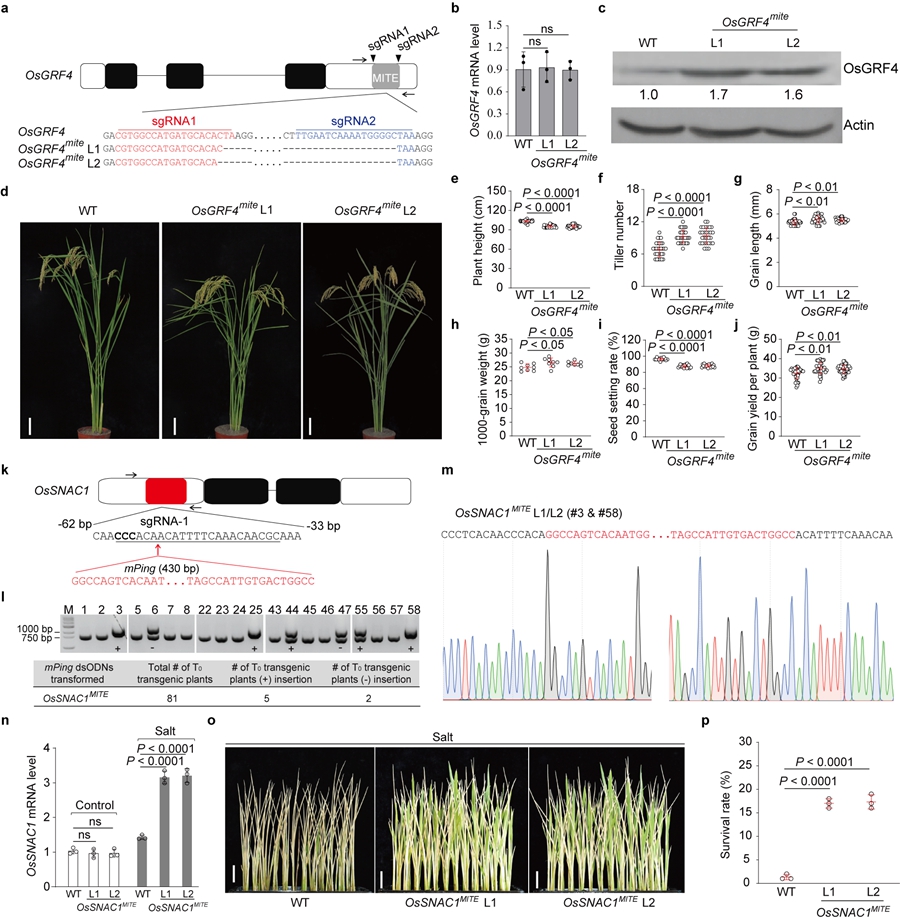A collaborative research team led by LI Jiayang from the Institute of Genetics and Developmental Biology of the Chinese Academy of Sciences and the Yazhouwan National Laboratory has reported that genome editing of transposons can rapidly improve rice traits.
Transposable elements (TEs) contribute to gene regulation and phenotypic diversity in plants. Miniature inverted-repeat TEs (MITEs) are short, non-autonomous DNA transposons (100-800 bp) that are numerically the most abundant TEs in the rice genome, and tightly associated with at least 58% of rice genes. MITEs have been shown to be a major driver of gene expression changes, and genome-wide association studies using MITE insertion polymorphisms may allow to dissect the underlying causal genes of agronomic traits.
As MITEs are an important source of genetic variation, this study hypothesized that genome editing (GE) of MITEs might be an efficient approach to generate novel alleles with altered gene expression for tuning crop traits. Two agriculturally important rice genes, growth-regulating factor 4 (GRF4) and stress-responsive NAC1 (SNAC1), were selected for study. Using CRISPR/Cas9-mediated large-fragment deletion or insertion technology, the researchers engineered the MITEs in the OsGRF4 and OsSNAC1 loci. A MITE deletion in the 3'UTR of OsGRF4 could increase the abundance of the target protein and improve many beneficial agronomic traits. A MITE insertion in the 5'UTR of OsSNAC1 could confer enhanced salt-inducible gene expression, thereby improving salt tolerance (Fig. 1).
In conclusion, the researchers showed that genetic engineering of MITEs in OsGRF4 and OsSNAC1 can create beneficial alleles for trait improvement in rice, providing a convenient and practical tool for crop breeding.
The research was published online on 1 October in the Plant Biotechnology Journal under the title "Generation of OsGRF4 and OsSNAC1 alleles for improving rice agronomic traits by CRISPR/Cas9-mediated manipulation of transposable elements" (DOI:10.1111/pbi.14465).
Fig. 1 Improvement of rice traits by genetic engineering of MITEs in the OsGRF4 and OsSNAC1 loci.
Contact:
Dr. LI Jiayang
Institute of Genetics and Developmental Biology, Chinese Academy of Sciences
Email: jyli@genetics.ac.cn
 Fig. 1 Improvement of rice traits by genetic engineering of MITEs in the OsGRF4 and OsSNAC1 loci.Contact:Dr. LI JiayangInstitute of Genetics and Developmental Biology, Chinese Academy of SciencesEmail: jyli@genetics.ac.cn
Fig. 1 Improvement of rice traits by genetic engineering of MITEs in the OsGRF4 and OsSNAC1 loci.Contact:Dr. LI JiayangInstitute of Genetics and Developmental Biology, Chinese Academy of SciencesEmail: jyli@genetics.ac.cn CAS
CAS
 中文
中文




.png)
